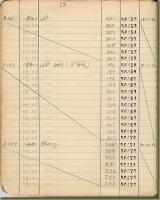-
Posts
558 -
Joined
-
Last visited
Everything posted by Mike Pierceall
-
Performed here: and here also on an Aeola with better audio settings.
-

Video: Making a Set of Bellows
Mike Pierceall replied to Mike Pierceall's topic in Concertina Videos & Music
Time will tell. I've never used butterfly end papers before, but the material I used is very thin with cross bonded fibers. The adhesive is very flexible, and there is very little bulk. The 8-fold bellows, minus the end frames, is less than 3 cm thick when compressed. The butterflies also took about half the time of installing than with conventional end papers. Thanks for watching and commenting. -
Not an instrumental video, but a silent record of building bellows. 8-fold, 8 sided, gold end papers. Here:
-

You Must Believe in Spring
Mike Pierceall replied to Mike Pierceall's topic in Concertina Videos & Music
Thank you. -
Jazz standard here:
-

Nightingale Sang for Treble
Mike Pierceall replied to Mike Pierceall's topic in Concertina Videos & Music
Thank you. I'm not sure there is much call for English concertina arrangements, Ha! But, no, I don't really publish or distribute. Sorry. -
A treble version of an arrangement I played first on a tenor-treble about 10 years ago. I though it was time for an update. I'm performing on the Wheatstone English Model 5A from 1918, that I restored recently, including building and installing a new set of 6-fold bellows. The video is here:
-
It is an arrangement I put together for playing on my concertina.
-
-
Chinese folk tune on a Wheatstone English system here:
-
Something from 1929 on a 1918 Wheatstone English concertina here:
-
Ultimately, a viable restoration depends on the condition of the reeds. Replacing all the missing buttons and repairing damaged fretwork is doable, but you might end up with an instrument that is still not worth much. I don't think it is German, unless it was marketed for the English-speaking market.
-
Keep it in a protective case, away from extremes of heat and humidity. Play it as often as possible. I've had more problems with instruments that have been lying idle than with instruments that are used regularly.
-
I see modifications such as the pivots for the lowest notes moved distally. I wonder if the left-hand side has similar changes. *Upon closer inspection I see that the pivots for the lowest notes seem to be in their original positions but fall outside the boundary of the disk, hence the extensions. Extra holes might indicate the springs were relocated? Very clean set of reeds and nice re-valving and padding. Yes, a Jeffries tenor English - a rarity twice over. I wonder why so few were made. Perhaps ahead of his time. I don't think Wheatstone tenors were made until the 1930s? Does anyone know? *Addendum
-
Date of manufacturer January 31, 1954. Nickle plated ends. Anglo. No idea of value. I'm not an Anglo player, but someone will know.
-

Automated Designs For Laser Cut Case
Mike Pierceall replied to RWL's topic in Instrument Construction & Repair
I use 1/4 inch Baltic Birch from Rockler and used rabbet joints. This is my video from about 3 years ago. I've made about a half dozen of these cases. Video is here: -
It seems to match up fairly closely with one way of estimating Lachenals: 17642 Divided by 769 = 23 + 1850 = 1873. Although from year to year production would vary, so always good to establish some milestones.
-

Wheatstone Aeola Tenor-Treble English Concertina
Mike Pierceall replied to Ray's topic in Buy & Sell
Sound files are useful, particularly something that demonstrates the responsiveness of the reeds. You might expand your market beyond a limited range of prospective buyers that live close by.- 14 replies
-
- Aeola
- tenor-treble
-
(and 1 more)
Tagged with:
-

1928 Wheatstone 30-Button C/g For Sale -Sold
Mike Pierceall replied to John Moran's topic in Buy & Sell
Placeholder for a missing badge? -
Sometimes referred to as "The Harvest Anthem," "To Thee, O Lord, Our Hearts We Raise" was written by William Dix in 1863. This is my arrangement for English concertina here:
-
Thanks, Don. Here is the link to the video: Not Vivaldi, though. It's one of my own. Not sure who I was channeling.
-

Post Wwii Wheatstone Reed Pans
Mike Pierceall replied to Greg Jowaisas's topic in Instrument Construction & Repair
I wonder if the possibility of error would not have been the reason for the design change. Maintaining the accuracy of the equipment and having experienced operators might have become problematic. A dwindling marketplace would have driven cost-cutting measures. Maybe the reject pile was just getting too high. -

Winter On Wheatstone 5A
Mike Pierceall replied to Mike Pierceall's topic in Concertina Videos & Music
Thank you, Don. ET in standard pitch, i.e., A440. -

Matusewitch Connection
Mike Pierceall replied to Mike Pierceall's topic in General Concertina Discussion
Thank you, Eric. I appreciate the added information. Although your father likely did not re-tune the instrument, he undoubtedly would have known where to refer major work on his students' instruments. There were two labels on the instrument case - the name and address of the owner, and the name and location of your father's studio. Mike


.thumb.jpg.c3b4d66c057112e3c4f45396196e858d.jpg)


